Would you ride 600 kays in the rain to pit a swathe of current-model big-bore Adventure bikes against each other in a state forest? Of course you would!
It’s amazing how much organisation goes into an adventure bike test like this one, so it’s lucky for me that AMCN journo Pete Vorst is so good at, well, organising stuff… like the bikes, the riders, the photographer, the destination and the route to get us there.
With everything seemingly under control, all that was really left for me to do was book the accommodation and pick up my stead from Husqvarna’s Sydney HQ and make a mental note of the designated start point and time for the upcoming 650km ride to Darlington Point, which is a quaint little town on the Murrumbidgee River in western NSW’s Riverina district.
After reading Chris Jones’ positive launch report on the Norden 901, I was keen to swing a leg over the Husky, but first I had to pack my gear for our three-day getaway. I affixed my Nelson-Rigg tankbag up front and strapped down my Oxford tailbag on the rear rack, the bags packed with tools, tyre repair kit, wet weather and thermal layers and a change of clothes for dinner at the pub.
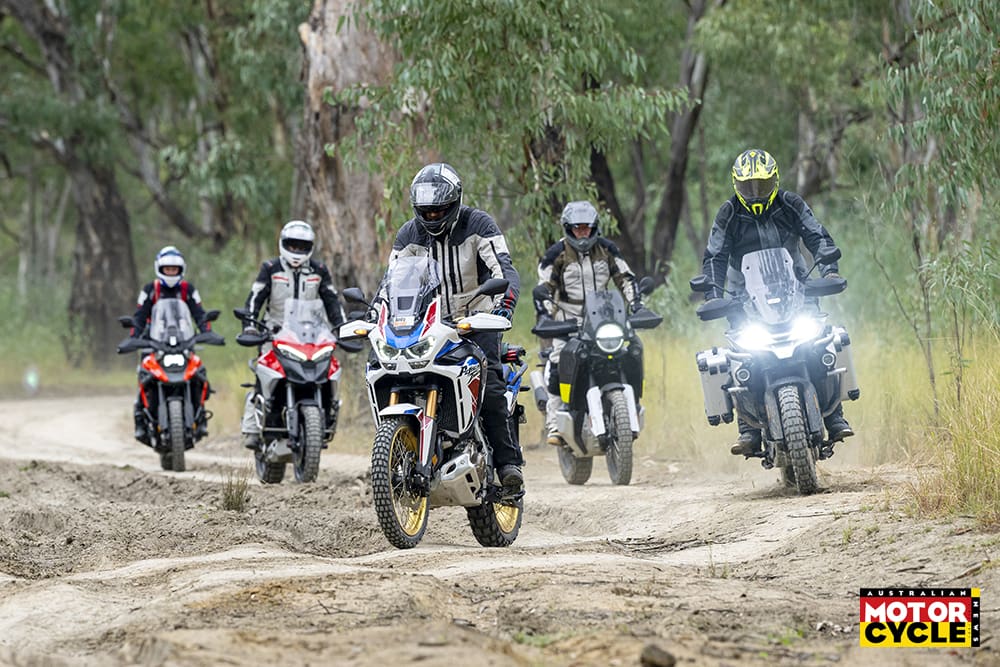
As is usually the case when heading south from Sydney, we met up early at the Pheasants Nest Caltex (now Ampol) for a coffee and a natter before putting some Hume Freeway kays under our tyres. While hardly exciting, starting on the freeway is a great way to familiarise yourself with a bike, flicking through the different rider modes and traction-aid settings.
The adventure bikes and riders in the Sydney group consisted Pete on the Triumph Scrambler, Jonesy on the Ducati Multistrada V4 S, photographer Watto on the CFMoto 800MT Touring and yours truly on the Husky. We would meet Melbourne-based Kel and Andy ‘Strapz’ White at our destination.
We’d only travelled 50km or so when we pulled up at the Derrick VC rest area on the Hume for a pitstop under cold and drizzling skies. Those who hadn’t already donned their wets took this opportunity to add some layers. We then continued down the Hume until Yass, where we fuelled up and grabbed a bite to eat, downed a coffee and swapped bikes for the next leg via Harden and on to Temora for fuel, then down to Coolamon (for more fuel), then to Narrandera (for even more fuel) and finally on to Darlington Point.
Why so many fuel stops? Because we didn’t take our own advice of fueling up when fuel is available, that’s why. Instead of filling up all the bikes at Temora, we just filled up the Trumpy, which was low on fuel, then by the time we got to Coolamon the CFMoto needed a top up, and then by the time we got to Narrandera the Ducati and the Husky were running low, at which point we finally decided to fill all four adventure bikes.

All of those fuel stops gave us all plenty of opportunity for a good stint on each of the bikes and we still managed to roll into the Darlington Point Accommodation Village before sunset where we were welcomed by owner Luke who happens to love adventure bikes (he has an Africa Twin). We then met up with Kel and Andy, unloaded the bikes and dropped our gear into the comfortable and sizeable cabin (yep, we weren’t really roughing it on this ride) and then wandered a kay or so down the road to the pub for dinner.
A dash from Melbourne to New South Wales’ Riverina region doesn’t exactly strike joy in the hearts of corner loving motorcyclists, but a ride’s a ride. And when you spend as many hours as we do chained to the desk, then it really doesn’t matter where you’re heading to, as long as you’re doing from the cockpit of a motorcycle.
Besides, one of the parts I love the most about any bike trip away is the day or two leading up to it when you’re gathering your kit together, working out your luggage, and what other bits and pieces you may or may not need in a bid to make the trip warm, dry, comfortable and safe.
It’s studying the map deciding how you’re going to make the most of the time on the road, it’s familiarising yourself with the adventure bike you’re riding to see what bells and whistles it has or hasn’t got and if and how you need to tailor it to suit your specific circumstances.

In the case of the Melbourne-based crew, which was myself and regular riding buddy Andy, it was a relative straight-forward experience thanks to the relatively straight roads and lack options between the Mornington Peninsula and Darlington Point.
In terms of bike set-up, I fitted a pair of wraparound aftermarket heated grips to the Suzuki V-Strom 1050 XT, wired up a harness to the battery to plug my heated jacket liner into, removed the bulky, heavy panniers and top box, opting instead for a roll bag attached to the pillion seat, stowed the bits and pieces I use regularly into Kreiga dry bag attached to the left-hand pannier bracket and I carried water in a hydration pack on my back.
Andy’s Africa Twin comes fitted with heated grips and, after a few trips of him coveting my heated liner, I spotted the familiar plug peeking out from under his seat this time, too. He, of course, opted for his own brand of luggage, and while he also ran a hydration backpack, opted to stow his regularly used bits and pieces in a tank bag – his own brand again.
The run from our neck of the woods to Griffith is a fairly easy 600km and easily completed in a day, but to make the most of the time away and make it feel like more of an adventure, we opted to leave after work the day prior, weave our way out of the busy city while also affording us a bit more time for a detour to at least sneak a couple of decent roads in on the way.
So instead of heading north west out of Melbourne bound for the Calder Freeway, we headed north east almost as far as Healesville and took the stunningly beautiful Chum Creek Road north, which was a first for me, but certainly won’t be the last. From there it was up to Yea and across to Seymour, with the last 30-odd kays up to Nagambie completed in the pitch-black dark.
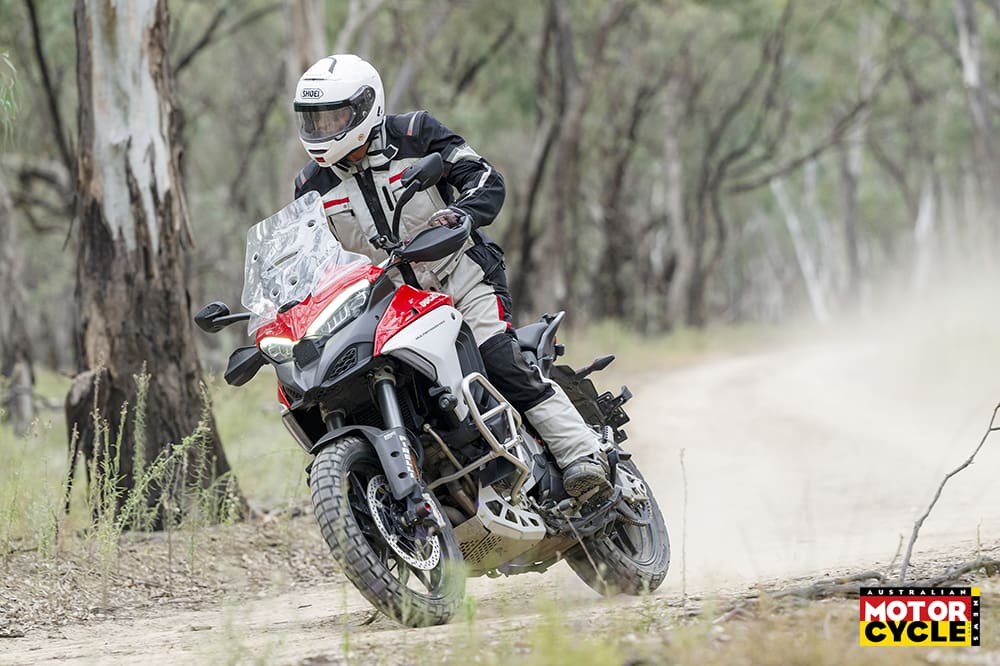
Despite being the top of the line model, the headlights on the Africa Twin leave a lot to be desired and the V-Strom’s were in desperate need of adjusting – they did an amazing job of lighting the 15 metres directly in front of me – so those last handful of kays on the road between the highway and the town were ridden Easy Rider style, two abreast either side of the white line to both get the light we needed while also staying as far away from the edge of the road and any errant wildlife that jumped into our paths.
But we got there, refuelled the adventure bikes before finding the motel and heading out to sample some of the local fare. I woke the following morning to some audible cursing from a familiar voice. And to be completely truthful, some familiar cursing from said familiar voice. You see, of the last four Adventure comparos, Andy’s been the custodian of the Africa Twin on three of them, and from the words reverberating around the carpark of Nagambie’s Centre Town Motel, I can reliably assume that the complex array of switches and buttons, both on the switch block and built into the large, colourful TT don’t get any easier to use as the years roll by.
Nothing a A look about in the morning – turns out Nagambie is the home of Phar Lap – and after a hot breakfast, we were back on the road bound for Darlington Point.

A three-and-a-half-hour ride later and we’re removing the luggage off the back of our adventure bikes. Andy sets off on foot for a look around, while I head another 30-odd kays north to Griffith to catch-up with seldom-seen family and to grab some supplies before returning to meet the Sydney crew.
Back from the pub we made the most of the wood that Luke had left for us and had a few too many drinks around a raging campfire. Luke had also pointed us in the direction of some local tracks that we could test the bikes on the following day. As always seems to be the case, things were falling into place…
Rather than head for the High Country we wanted red dirt and dust for this year’s AMCN adventure ride, which is why we ended up in the Riverina, with riders coming up from Melbourne and across from Sydney. Sure, it was a long way for everyone to travel for a day in the dirt, but all were keen when we they saw the route Pete had mapped out.
We had originally planned to cover a few hundred kays of dirt on the second day of our ride, looping around to the north of Darlington Park and back to our accommodation, but of course the weather had other plans, and with only a small window of sunshine forecast for the morning, we had to come up with a Plan B.
Thankfully our host Luke at the Darlington Point Accommodation Village pointed us in the direction of some fabulous tracks that ran alongside the Murrumbidgee River just a short ride away, which allowed us to sample each adventure bike in the dirt and to compare notes. There was a mixture of fast open dirt, some muddy sections, a few small jumps, and some tight single track through the trees.
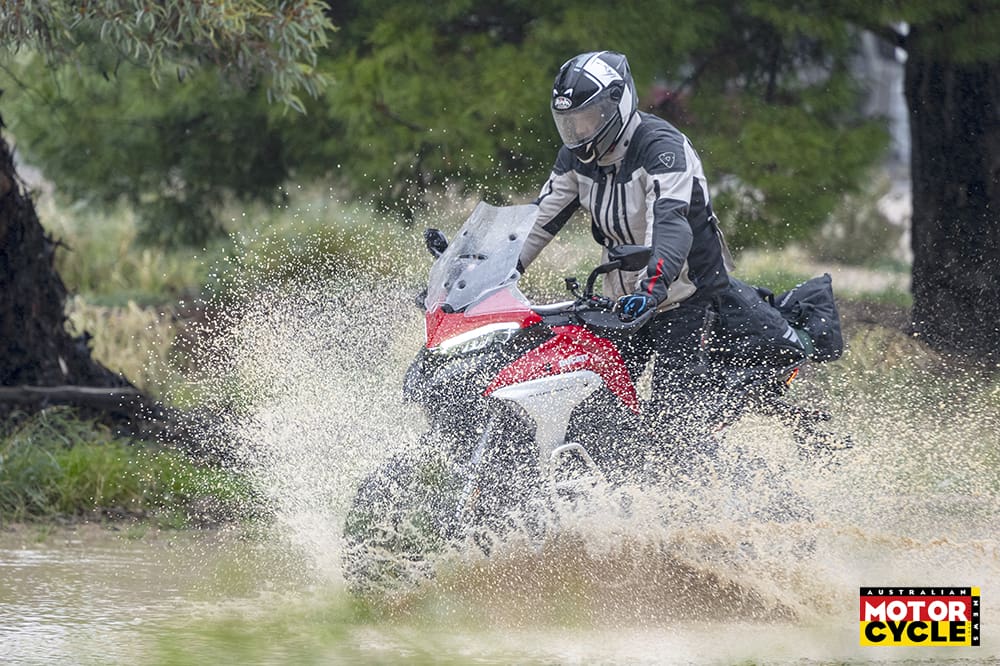
As predicted, the rain arrived by lunchtime and after a few wet laps we had the photos in the bag and we called it quits before heading back to base to dry out and warm up. That evening we wandered back down to the pub for dinner and then had a much earlier night than the one previous.
The next morning it was raining steadily as we loaded up the bikes for the ride back home. Kel and Andy got away first and reckoned they were soon rolling under blue skies for the ride back to Melbourne. No such luck for Jonesy, Watto, Pete and I, however – we would cop a drenching all the way back to Sydney.
Rather than double-back the way we came, we headed east to Whitton, through to Leeton and then along a series of backroads to Temora. We then took a few more backroads and popped out on the Hume Freeway just to the west of Yass for a final feed. And despite the crook weather, that ride from Darlington Point to Yass was bloody great fun along unfamiliar roads on what were now familiar adventure bikes.
The 2022 AMCN adventure ride might not have been the red-dust fest we’d originally planned, but we certainly managed to get dirty… and to ride some mighty fine motorcycles in the process, both on the road and off it.
CFMoto 800 MT Touring
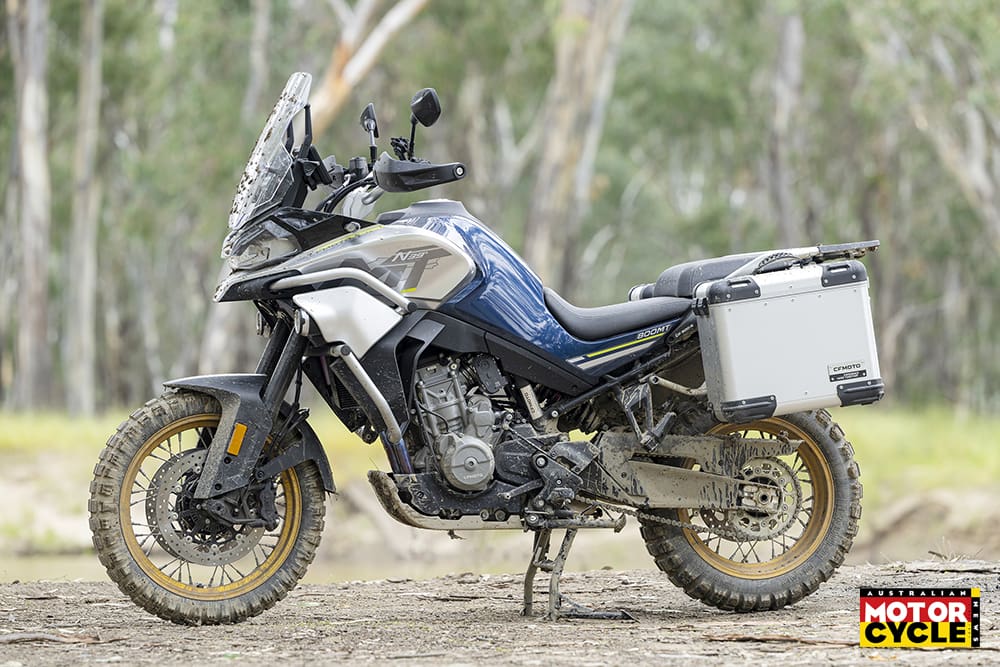
For a mid-size adventure bike, the CFMoto Touring-spec machine has all the mod cons for punching long kilometres on tarmac: cruise control, ABS, fog lights, a two-way quickshifter, heated seat and grips, tyre-pressure monitoring, adjustable screen, seven inch TFT display – the list is impressive for the price. But it wasn’t love at first sight.
I’d been looking forward to riding the bike since I heard Deano talking about it after the launch and I was excited for the adventure ahead. And with the drizzly rain forecast to get a lot worse, I hastily loaded panniers, strapped on a drybag and took off. And that’s where things went sideways … literally.
Okay, I didn’t check the tyre pressures, nor did I familiarise myself with the modes and electronic aids, I didn’t even know if had shiny new tyres fitted – I just wanted to get the show on the road – I’d sort that stuff out on the freeway. And so when I was fishtailing down the road in what turned out to be Sport mode and on what turned out to be fresh Mitas E10 Enduro rubber, I wondered what the traction control system was waiting for?!
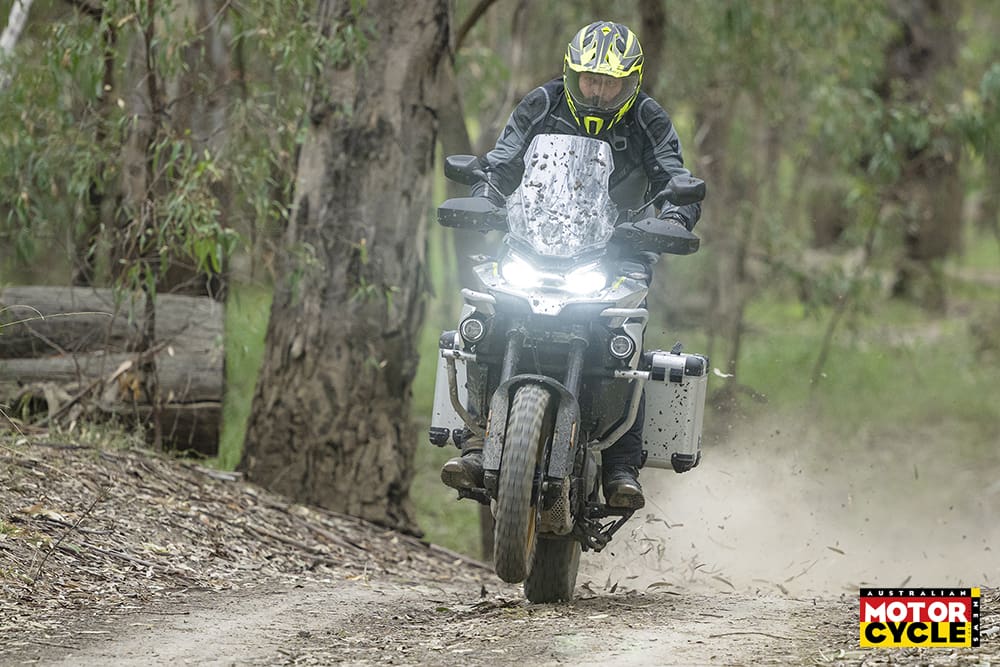
Admittedly, new tyres, heavy panniers, a lack of preload adjustment and a hasty getaway were all part of the poor equation, but it was the power delivery which took me by surprise. The thing felt super squirmy and it took a good few kays for myself and the bike to settle. And just as I started to get a good feel for everything underneath me, the tyre pressure warning light started flashing. A quick pitstop confirmed the 800MT’s pressure monitors don’t like Mitas Enduro tyres, and Loctite is needed on the rear-view mirror nuts, but once back on the road, the tide turned in the bike’s favour.
The cockpit is roomy for my 188cm frame and the 825mm seat height means for easy foot planting at traffic lights. The 799cc twin delivers ample power for highway kilometres and quickshifting is great when you hit the sweet spot. Drop onto the dirt and the 800MT once again behaves remarkably well. An ability to semi-lock up the rear is a bonus, as is the hefty bike responding appropriately to firm manhandling. Mud rapidly renders the pegs unusable, but whip out the screw holding the rubber insert in place and grippier enduro pegs await.
The lack of traction control is difficult to forgive in 2022, as is the light-switch throttle and iffy fueling, but otherwise the 800MT handled most of what was thrown at it. Truthfully, the CFMoto 800MT Tourer is incredible bang for buck. It doesn’t do everything perfectly, but it does do most things well. There aren’t many sub-$15k adventure bikes you’d happily take straight from the showroom floor to ride around Oz, but the CF-Moto 800MT might just be one you would.

1. The 799cc twin delivers ample power
2. There is a touch of Multistrada in the styling
3. The display does not look cheap, even in this company
Ducati Multistrada V4 S

Dubbed as one of the most technologically advanced bikes in the world, Ducati’s Multistrada V4 S provides a lot of features which I could spend all day writing about. But I’m going to focus on the ride impression – note though, with a belter of a toothache my head wasn’t in a good place, and knowing I was on one of the safest motorcycles on the market put my mind at ease.
Wet rides aren’t much fun, but the Multistrada not only made it bearable but quite enjoyable. The bike had been set in Touring mode, which softens the electronic suspension and I left it there, it was so compliant on our crappy country roads and while it wasn’t the most exciting trip to Darlington Point, cornering and braking behaviour was as good as anything I’ve ridden – it’s rock solid. Day two saw us venturing onto some pretty mild dirt which it handled nicely, but the top-spec Africa Twin was by far the best of the bunch off-road for me.

As expected, the V4 is a rocket – it thrives on revs but I think I prefer the V-twin variant I rode a couple of years ago which seemed to have a lot more torque lower in the rpm range. On paper it doesn’t, but riding them paints a really different picture. It loves a drink too, the 22L fuel capacity will get you no more than 330km. It is, after all, a detuned long-travel Panigale.
Comfort is best described as superb. The seat is lovely and for me at 180cm the position of the handlebar was perfect when sitting or standing. The heated grips were the best I’ve used and were a very welcome addition during our cold, wet journey. The easily adjusted windshield does a great job of keeping you dry and warm, as do the fairings.
Scrolling through the many functions of the dash takes a bit of time to figure out, I feel it could be simplified, but it would no doubt become second nature with more time in the saddle. The adaptive cruise control is okay but can be annoying when you approach a vehicle in the left lane in front of you on the freeway and it wants to slow down, if you start to overtake further back, it’s fine but I turned off the adaptive function in the end and just ran with the normal cruise.
It’s a lot of bike, sure, but it’s also a lot of money. It eats up country riding with ease and would embarrass many sportsbikes on most windy roads. It nails the intended purpose for those who will spend the majority of time on the tar, it’s not a bike I would like to take too far off the beaten track.
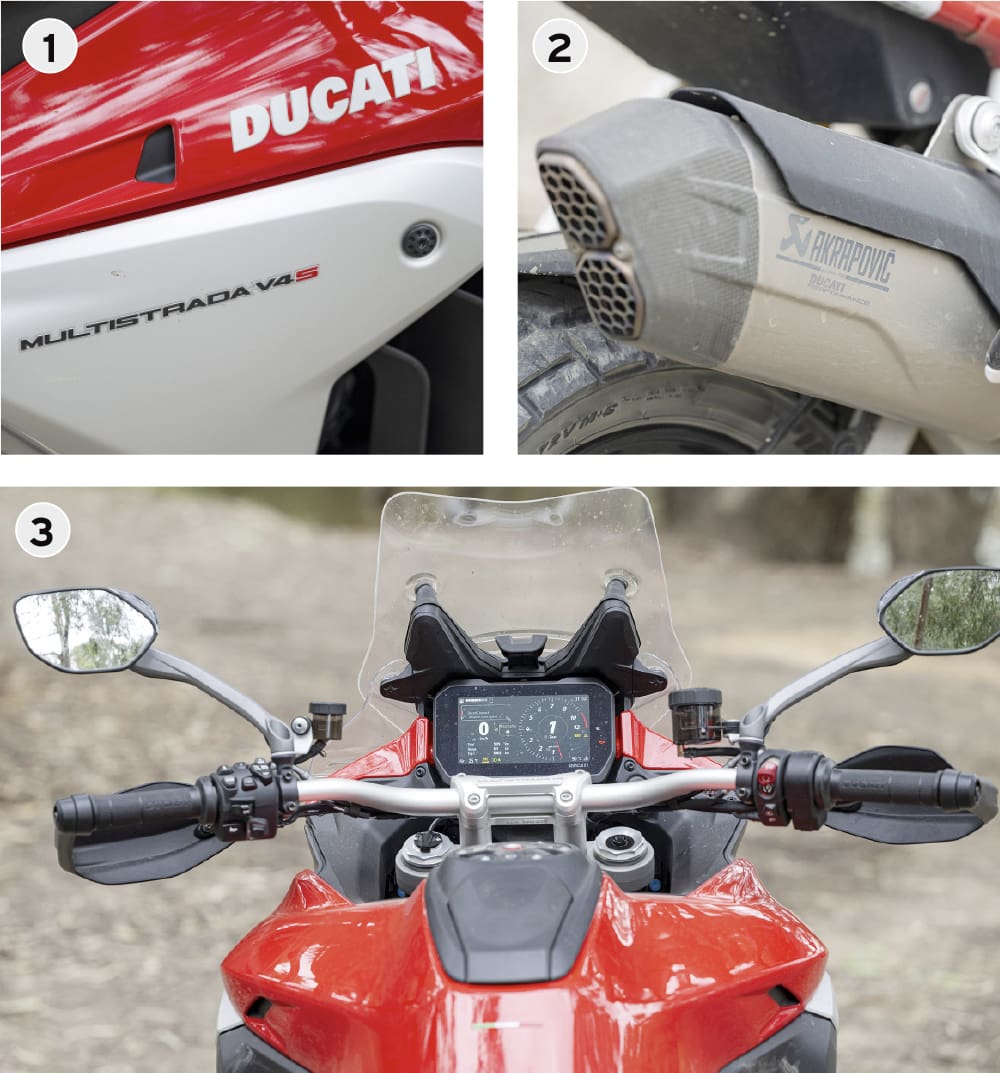
1. A Superbike in adventure clothing? Yes, it is a bit
2. Akrapovic pipe is a nice high-end touch
3. Cockpit is a comfortable place to be
Honda Africa Twin AS ES
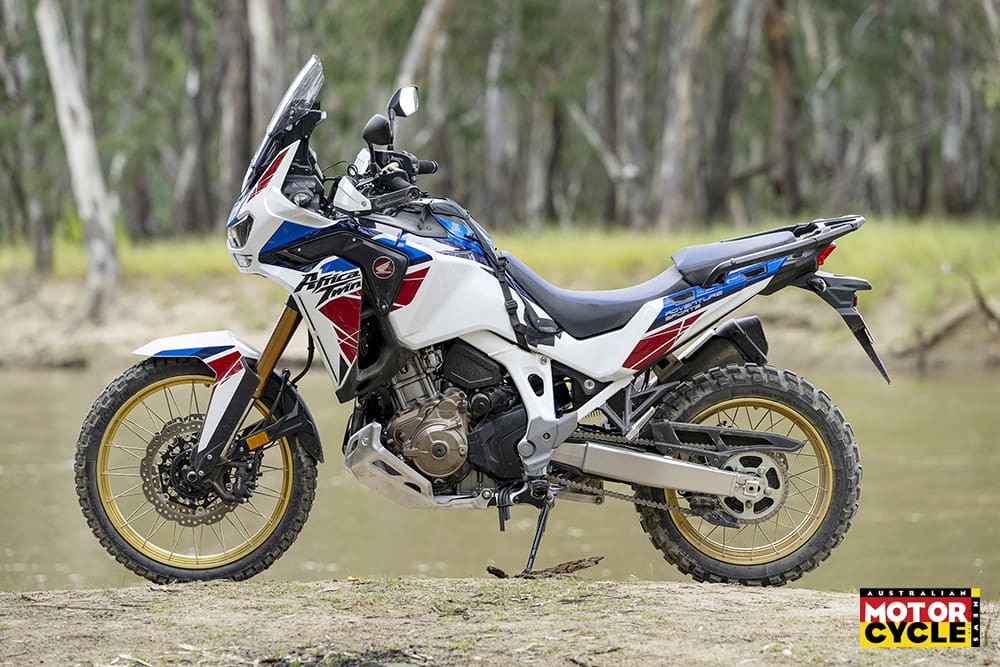
When I got the call to join this year’s adventure comparo, I was chuffed. When I found out that I’d be riding the Honda Africa Twin DCT again, I went looking for a tanty-chuckin’ emoji – my fourth adventure comparo and now my third on the AT.
That was until I saw Pete’s plan… 12 hours of highway riding (in the rain) with one day’s ride in the bush. Hunkering down behind that big, familiar tank with the screen on the tallest setting, knocking over tank after tank of fuel in suspect weather was not a bad first-world problem. That syrupy motor purring away in front of the slick DCT transmission (now tweaked for smoother first- and second-gear response). Combine that with the refined semi-active suspension sucking up the bumps on the ’22 model… just the ticket.
This year’s model changes are more than skin deep. Refinement was Honda’s approach, from windscreen to cylinder-head gas flow, phone connectivity to emergency-stop flashing indicators, a slightly higher ’bar and self-cancelling indicators.
The dash menu system is still complicated and tedious, despite having the user manual in your hands. After a couple of hours, I gave up – a month or two of ownership would simplify things, I’m sure. I can’t find it listed, but a very welcome update this year is how it provides me with better access to mother earth. I feel a lot more secure (on the low-seat setting) when paddling it about a carpark. Maybe it’s just a narrower profile.
While on the topic of parking and mother earth, an adventure bike should be robust enough not to break in the event of stationary topple. The Africa Twin is not.
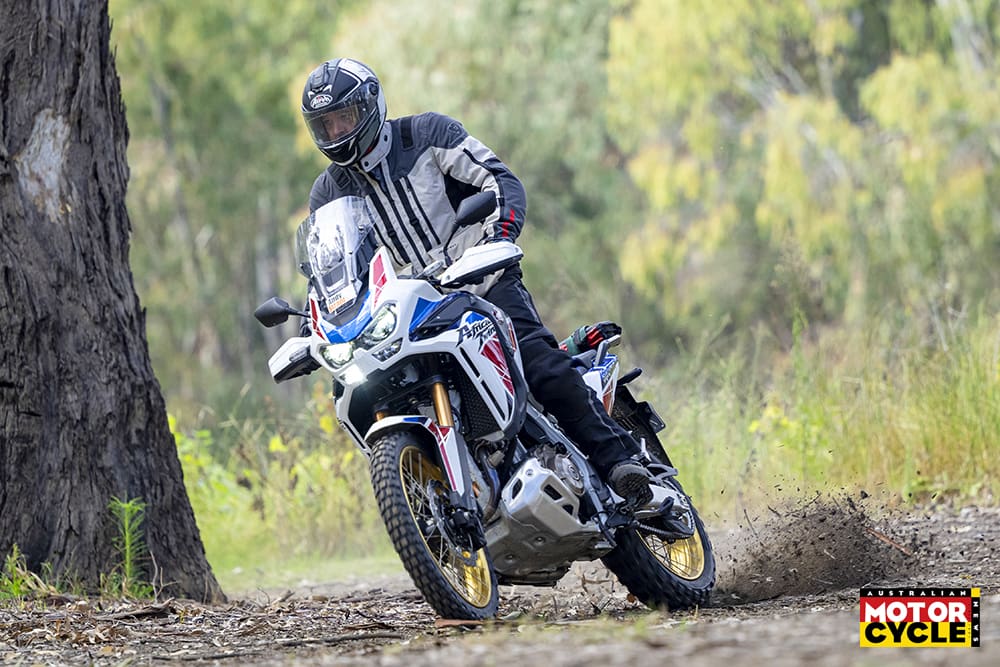
I was critical of the 2019-model headlights and I’m still grumbling. The cornering-light function comes on when required, but disappears too quickly as the bike returns to vertical. No one wants less light at night and it’d be good to have the option to leave them on.
But it wasn’t until I started to sample other bikes that the refinement and capability of the Africa Twin showed through. Out on the rougher dirt, I was surprised by the performance of the suspension. It imbued confidence on such a big bike, I felt comfortable pushing a little harder and quicker.
I sampled the road handling with an uninterrupted dash through the famous Chum Creek Road. Popping the DCT in manual mode and used the hand-operated paddles as much as I would a quick-shifter was a delightful experience. Sharp, fast and smooth.
On the speed limit on the highway, I had cars and trucks up my clacker and checked the speedo against a GPS app on my phone GPS app – it was out by nearly nine percent! In an age when we get fined for three clicks over, that’s unacceptable. I know design regulations allow up to 10 percent variation, but I expect better accuracy from Honda in this day and age.

1. The DCT transmission gearchange buttons are a treat.
2. Simplicity in the well thought-out design
3. Dash is clear but menu complicated
Husqvarna Norden 901
 Big, heavy adventure bikes can be a bit intimidating for riders of shorter stature, but the Husqvarna Norden 901 is one of the most comfortable and easy-to-ride dual-sport bikes on the market.
Big, heavy adventure bikes can be a bit intimidating for riders of shorter stature, but the Husqvarna Norden 901 is one of the most comfortable and easy-to-ride dual-sport bikes on the market.
With a 21-inch front wheel, decent off-road rubber (Pirelli Scorpion Rally STR), long suspension travel and plenty of ground clearance, there’s no doubt the Norden can mix it with some of the best adventure-tourers in the dirt, but the relaxed riding position that has you sitting in the bike more than on top of it makes it feel smaller and more manageable than some others. Sure, the seat height is still up there at 854mm, but once aboard it feels like a smaller bike than it actually is.
As a back-roads blaster, the Norden is impressive. The 889cc parallel twin makes plenty of grunt from low in the rev range and has decent poke up top, while gearshifts are aided by a two-way quickshifter. There are three ride modes (Street, Rain and Off-road) and although it was raining for much of this test, I ran the Norden in full-power Street mode for just about all of the ride, only flicking into Rain mode to see what it was like. The testbike was fitted with the optional Explorer mode that allows you to customise traction control and throttle response to slide the bike more, or less, when riding off road, but I found the standard Off-road mode perfectly suited to the dirt.
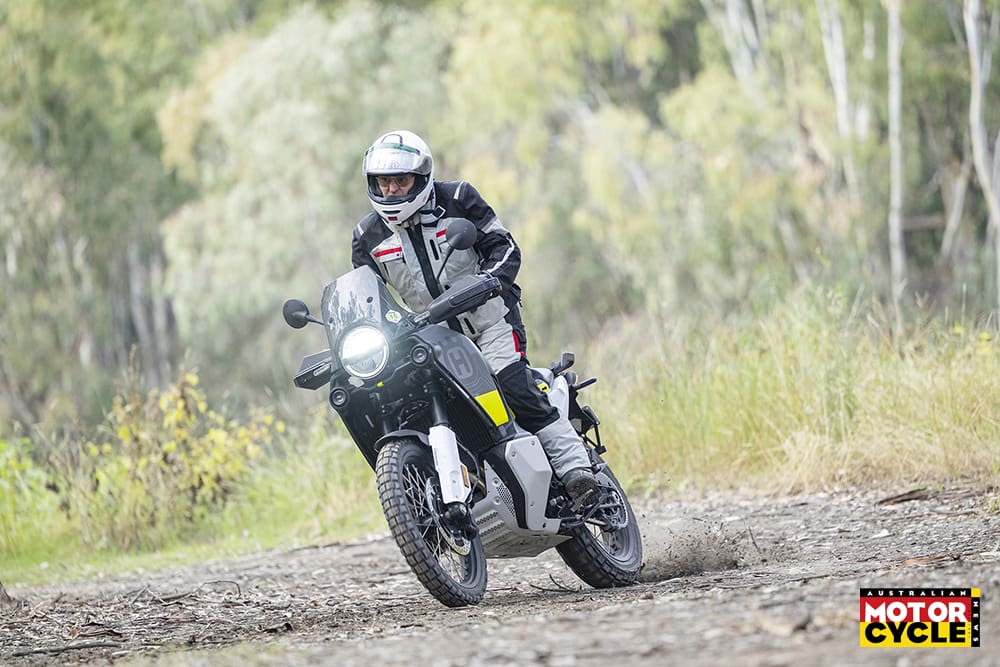
The fully adjustable WP suspension offers a great combination of compliance and control over crappy road surfaces, while the reassurance of cornering ABS and traction control allows you push harder than you otherwise might, even when it’s bucketing down. And it’s a hoot in the dirt. It might weigh a hefty 204kg (dry), but it feels lighter, and you’ll soon be flicking it through singletrack like you’re on a big enduro bike. The wide ’pegs and narrow fuel tank make standing up on the bike feel natural, and the abundance of torque throughout the rev range and the spot-on fuelling means you can poke along at low revs, or you can grab a handful of throttle and let it rip, with the traction control quickly intervening if you get a bit too carried away. The light and progressive clutch helps when riding over off-road obstacles too.
The seat is generous and well padded, and I found the ergonomics well suited to my 167cm frame. Although the screen isn’t adjustable, it provided good protection at highway speeds and I didn’t experience any buffeting.
The Norden’s controls are intuitive and easy to operate, and the TFT screen is bright and non-reflective, although it seems odd that Bluetooth connectivity is an option, as are heated grips. When I stepped off the Norden at the end of a very wet 650km day, I felt fresh and with no pain, and that’s exactly what you want in an adventure tourer.

1. The 889cc parallel twin is up to most tasks
2. The Norden carries Husqvarna’s family look
3. Changing the settings is child’s play
Suzuki V-Strom 1050 XT

Two years ago, Suzuki updated its long-standing V-Strom 1000 to this latest 1037cc V-Strom 1050 XT and, while many fans of the Japanese brand hoped it would rival the likes of the segment’s big hitters, it does lack some of the off-road credentials of required to do that convincing.
But that’s not to say it’s a bad adventure tourer. Quite the opposite. And, at $21,990 ride away, it’s bloody good value. The 19-inch front wheel makes it a pretty handy go-most-places machine and offers more feedback on the road than a larger and skinnier 21-incher.
The update includes cruise control for the first time, as well as three switchable riding modes, the cornering traction control can be turned off, although the ABS cannot. And as well as having a rather convoluted and hard to see LCD dash, you can’t change modes, flick between trips or check your fuel range if the cruise control is active, as all of the settings are accessed through the same multi-function buttons on the left-hand switch block.

The updated electronics package also includes hill hold control and Suzuki’s version of stability control, which puts it in the company of machinery which much higher price tags. In terms of comfort, it’s spot on –– though heated grips shouldn’t be an optional extra on a bike like this – the seat is supportive, roomy and all-day comfortable and when the manually adjustable screen is set to the highest position, it offers excellent protection. And better than the Africa Twin’s.
That adjustable screen is part of the extra kit given to the XT, along with wire-spoked tubeless wheels, a centerstand, engine crash bars and plastic handguards. The bike arrived with the optional (and expensive at $3599) panniers and top box, which I didn’t want or need, not least because the bike already weighs nearly 250kg without them and my 164cm frame needs all the help it can get when it comes to bouncing around in the bush.
The V-twin engine is usable and predictable, as one that’s been around for 20 years should be. It’s claimed 79kW (106hp) at 8500rpm and 100Nm of torque at 6000rpm won’t earn you any raised eyebrows in the pub, but there’s plenty of power to overtake quickly and efficiently and it’s made in a way that’s really practical off road.
The KYB suspension is more suited to sealed sections than the state forest we found ourselves in on the second day, but most riders who buy this bike are likely to be more suited to long-distance back road touring than hard-core adventure riding anyway.
There’s both a USB and 12-volt power outlet and, unlike a surprising amount of bikes these days, the battery is very easy to get to. With what has proved itself to be a bulletproof engine, and a very appealing price for what’s a really competent all rounder, it’s little wonder the latest V-Strom 1050 XT already has a strong following.
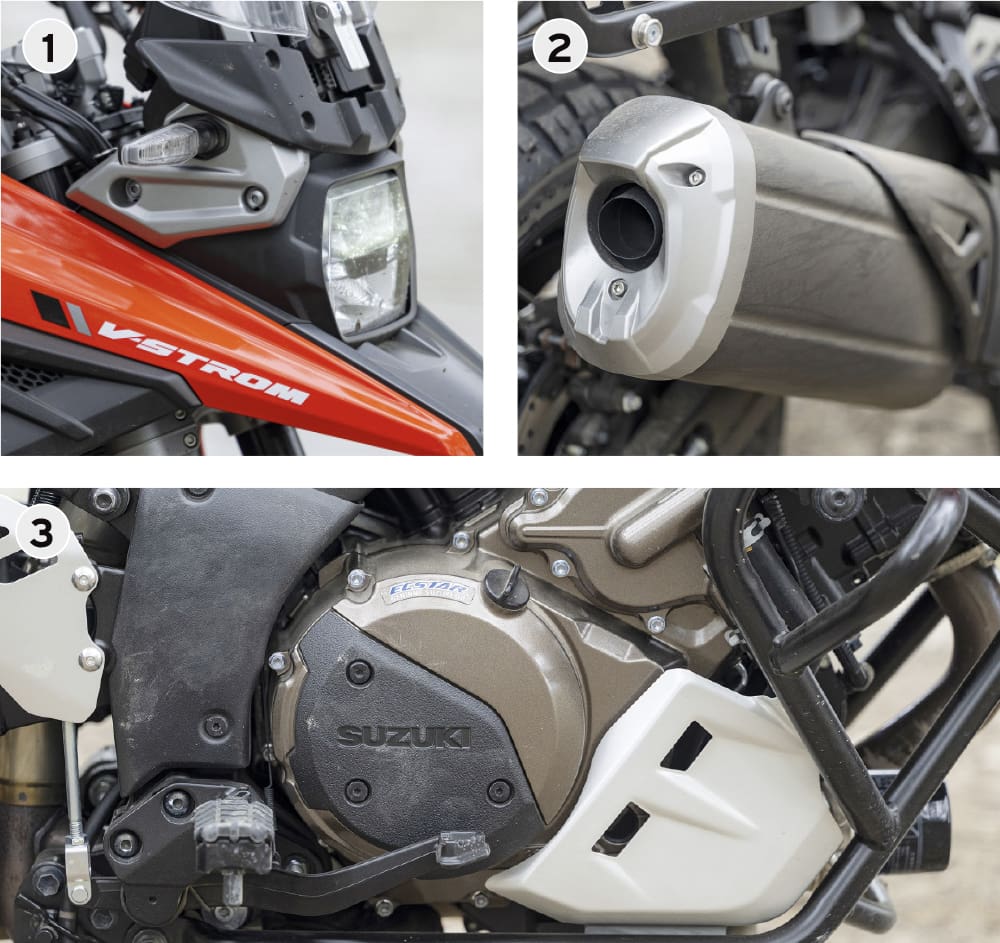
1. Lighting could be stronger
2. Not much sound emerges from that muffler
3. The V-twin has proven itself to be a reliable performer
TEST: DEAN MELLOR & KEL BUCKLEY PHOTOGRAPHY INCITE IMAGES